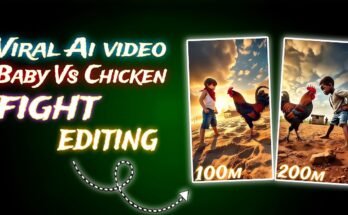Transforming Fruit into Animals with AI. world of Artificial Intelligence (AI) is continuously evolving, breaking boundaries, and revolutionizing how we perceive creativity, art, and even nature itself. One of the most fascinating intersections of AI and art is the ability to transform everyday objects, like fruits, into unexpected entities—such as animals. Through advanced machine learning algorithms, artists, designers, and researchers have discovered innovative ways to blend nature with technology in ways previously thought impossible.
This blog post delves deep into the concept of turning fruit into animals using AI, exploring the technologies behind it, the creative potential it unlocks, and how it impacts industries like design, art, and even education.
Understanding the Power of AI in Art
Before diving into how AI turns fruit into animals, it is essential to understand the broader context of AI’s influence on art and creativity. AI, through machine learning (ML) and deep learning (DL) models, has become an invaluable tool in the creation and manipulation of visuals. These models are capable of processing vast amounts of data, learning patterns, and generating content that mirrors or even surpasses human creativity.
The most well-known AI technologies in the art world are Generative Adversarial Networks (GANs), neural networks, and convolutional neural networks (CNNs). These AI models can manipulate images by interpreting visual inputs and generating unique outputs. For instance, GANs are particularly effective at creating hyper-realistic images of objects, people, and animals based on the data they’ve been trained on.
These advancements have led to the emergence of AI-generated art, where machines are involved in the creative process. Now, imagine combining these AI techniques with nature’s colorful and diverse fruit world—creating surreal and innovative images of fruits turning into animals.
The Process: Turning Fruit into Animals with AI
Transforming fruit into animals using AI involves multiple steps and cutting-edge technologies. The process typically begins with collecting or generating an image of a fruit and using it as input for an AI model. Here’s an outline of how it works:
1. Image Collection and Preprocessing
The first step in the AI transformation process is gathering high-quality images of fruits. These images can be sourced from online databases, personal collections, or creative commons platforms. The AI model needs a substantial dataset to learn from, so images of various types of fruits (e.g., apples, bananas, oranges) are used as training data.
Preprocessing the images involves resizing, normalizing, and sometimes segmenting the fruit images. In some cases, artists may even create stylized or abstract representations of fruits to further push the boundaries of creativity.
2. Training the AI Model
Once the dataset is ready, the next step is training the AI model. This step involves using deep learning algorithms like GANs to help the AI understand the visual characteristics of fruits and animals. By training on a large collection of fruit and animal images, the AI learns to associate certain visual elements in fruits with their animal counterparts.
For example, the AI might learn that the round shape of an apple resembles the round body of a seal or the peel of a banana could be similar to the body texture of a snake. The model uses this learned information to creatively merge the two, producing hybrid images that blend the features of fruits and animals.
3. Generating Hybrid Images
After the AI has been trained, the next step is to generate the hybrid images of fruits transformed into animals. Here, the machine uses the visual patterns it learned during the training phase and applies them to new input data (e.g., an apple). Through the magic of deep learning, the AI can create something entirely unique: a fruit animal.
For example, the AI might generate an image of a lion with a body that is made entirely of peaches, or a bird whose wings are formed by delicate watermelon slices. These creations are not only surprising but often surreal, blending the colors, shapes, and textures of fruits with the recognizable forms of animals.
4. Refinement and Fine-Tuning
After generating the initial hybrid image, the output is usually not perfect. The AI-generated images are often raw and require human intervention for refinement. Artists and designers use advanced tools, like Photoshop or other graphic editing software, to fine-tune the images.
Fine-tuning involves smoothing out inconsistencies, adjusting color palettes, and enhancing details to make the fruit-animal hybrid more visually appealing or realistic. Additionally, filters and textures may be added to make the transitions between fruit and animal features more seamless.
5. Final Output
Once the image has been refined, the final output is a stunning piece of artwork: a hybrid fruit-animal creation. These pieces can be used for various purposes, such as digital art, advertisements, product designs, and even in educational materials to spark creativity and discussion about AI’s potential.
The Creative Potential of AI in Fruit-Animal Transformations
The fusion of fruit and animals through AI has immense creative potential. By leveraging the capabilities of deep learning, artists can explore a new realm of possibilities that were previously unthinkable. Here are some of the exciting ways AI-driven fruit-animal transformations are being used:
1. Surreal Art
AI-generated art is already a popular niche, but blending fruit with animals takes it to an entirely new level of surrealism. These hybrid creatures can evoke strong emotions and spark the imagination of viewers. Whether used for gallery exhibitions, online digital art, or social media posts, these hybrid creations often blur the lines between reality and imagination.
Artists can push the boundaries of what is possible by experimenting with various fruit-animal combinations. A pear could become the body of a horse, or a grape could be the tail of a fish. The result is an endless world of bizarre and intriguing visuals that intrigue and captivate audiences.
2. Design and Branding
Fruits and animals are both familiar to people, and combining them in unexpected ways can create unique and memorable visual identities for brands. Companies in the food and beverage industry, especially those in the fruit or health sectors, can use AI-generated fruit-animal art in their branding campaigns, advertisements, or product packaging.
For example, a juice company might use an AI-generated animal made from oranges as their mascot. This kind of branding is not only visually interesting but also memorable, as it stands out from traditional, more conventional designs.
3. Education and Research
The fusion of fruits and animals through AI also has potential applications in education. Educators and researchers can use AI-generated images to engage students, making lessons more interactive and stimulating. For example, a biology lesson on the animal kingdom could incorporate AI-generated fruit animals, teaching students about the anatomy of both fruits and animals while encouraging them to think about creativity and innovation.
Moreover, the concept of blending different natural elements might open the door to new types of research on how AI interprets and mixes visual data. This cross-disciplinary work could lead to breakthroughs in understanding how we process visual information and how AI can simulate human creativity.
4. Virtual Reality and Gaming
The realm of virtual reality (VR) and gaming offers an exciting avenue for AI-generated fruit-animal hybrids. In gaming environments, these hybrid creatures can be used as imaginative characters, making the game world more colorful, quirky, and unique.
For instance, a virtual game might feature a forest inhabited by animal-plant hybrids that include fruit-based creatures. These animals could take on new behaviors, movements, and abilities, offering players an immersive and novel experience. AI-generated fruit animals could also be integrated into storytelling, providing unexpected plot twists and visually stunning moments in VR environments.
Challenges and Ethical Considerations
While the creative potential of AI in transforming fruit into animals is undeniable, it does raise several challenges and ethical considerations.
1. Quality Control and Authenticity
AI-generated content, including fruit-animal transformations, can sometimes lack the quality and attention to detail that human artists provide. The accuracy and realism of the hybrid images depend heavily on the quality of the training data and the AI model used. Ensuring that AI creations maintain a high standard of artistic integrity is a significant challenge.
2. Copyright and Ownership
With AI-generated art becoming more prevalent, questions surrounding copyright and ownership are inevitable. Who owns an AI-created fruit-animal hybrid? Is it the creator of the AI model, the person who provided the input data, or the artist who refined the final image? These are important legal and ethical issues that need to be addressed as AI-driven art becomes more widespread.
3. Bias in AI
AI models learn from the data they are trained on. If the training data is biased, the output generated by the AI will also reflect those biases. For example, if an AI model is trained primarily on Western fruit and animal images, it may struggle to create accurate or diverse representations of non-Western species. Ensuring diversity and inclusivity in AI training data is crucial for avoiding bias and promoting fairness.
4. Environmental Impact
The development and training of AI models require substantial computational power, which contributes to energy consumption and carbon emissions. While AI offers many benefits in creative fields, it’s essential to balance these benefits with sustainability efforts to reduce its environmental impact.
Click Here
Conclusion: A New Frontier for AI and Creativity
Transforming fruit into animals with AI is a prime example of how technology can expand the boundaries of imagination and creativity. With the ability to blend nature with technology in novel ways, AI is opening up new possibilities for art, design, education, and entertainment.
By using advanced algorithms like GANs and deep learning models, AI can create surreal and visually stunning hybrid creatures that inspire, educate, and entertain. However, as with any new technology, there are challenges that need to be addressed, particularly regarding quality, copyright, and environmental sustainability.
Ultimately, the ability to turn fruit into animals with AI represents just the beginning of a new era in creative exploration. As AI continues to evolve, we can expect even more exciting innovations and artistic breakthroughs that push the limits of what we thought was possible.
For more insights on the latest AI trends and content creation tips, check out other articles on TechBN.



